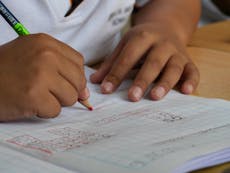NWEA MAP Test Questions and Answers 2025
All products and services featured are independently selected by WikiJob. When you register or purchase through links on this page, we may earn a commission.
- A List of NWEA Map Tests Available for Practicing in 2025
- What Is Being Assessed in the MAP Test?
- What Does ‘Adaptive’ Mean in MAP Testing?
- Question Formats and Types of the NWEA MAP Testing?
empty
empty
empty
empty
- What to Expect When Taking the MAP Test in 2025
- MAP Growth Practice
empty
empty
empty
empty
empty
empty
empty
empty
empty
empty
empty
- Tips on How to Do Well on the MAP Test in 2025
- A Parent’s Guide to MAP Growth
empty
empty
empty
empty
empty
- Frequently Asked Questions
- Final Thoughts
A List of NWEA Map Tests Available for Practicing in 2025
- Kindergarten MAP Growth Practice
- 1st Grade MAP Growth Practice
- 2nd Grade MAP Growth Practice
- 3rd Grade MAP Growth Practice
- 4th Grade MAP Growth Practice
- 5th Grade MAP Growth Practice
- 6th Grade MAP Growth Practice
- 7th Grade MAP Growth Practice
- 8th Grade MAP Growth Practice
- 9th-12th Grade MAP Growth Practice
The MAP test (or Measures of Academic Progress test) is an adaptive assessment for children ranging from grades K (kindergarten) through to 12th grade. It measures student achievement over time.
The MAP test varies from the usual format of academic tests where each child answers the same questions.
Instead, the MAP test is adapted to each child based on their grade level, featuring questions that are suited to that child’s academic standard.
The MAP test is created and maintained by the Northwest Evaluation Association (NWEA).
For more information on how the MAP test is scored, see our dedicated article.
What Is Being Assessed in the MAP Test?
The purpose of the MAP assessment is:
-
To assist teachers in identifying a child’s strengths and weaknesses. This points to the academic areas where a child may be challenged and pushed further, and the areas where more work and support is needed.
-
To track the child’s academic achievements and developments through their time at school.
-
To compare the child’s academic growth with what is expected for a particular school year, for example, is a year one child reading at the level of a year two child?
-
To make it possible to predict a child’s academic development, achievement and grades, and investigate where this prediction is not met.
The MAP test assesses reading, language use and mathematics across the entire age range.
For certain age groups, knowledge of general sciences will also be assessed.
What Does ‘Adaptive’ Mean in MAP Testing?
The MAP test is ‘adaptive’ in that it adapts to the answers given during the assessment.
If a child answers a question incorrectly, the following question will be at an easier level. If a child answers a question correctly, the following question will be at a more difficult level.

Question Formats and Types of the NWEA MAP Testing?
The questions included in the test will be suitable for the child’s age group, as well as their individual academic level.
For example, questions for kindergarten age children will have audio questions for children who might struggle to read and brightly colored image-based answer options; questions for older year groups become more tricky.
The format of the questions will vary and may include drag and drop, multiple-choice and fill in the blank questions.
The NWEA test assesses four different areas:
- Reading
- Language use
- Math
- In some cases, general sciences
Practice MAP Test: Reading Section
The purpose of the reading section is to assess the child’s understanding of different written formats, their ability to analyze written passages and whether they can use linked themes, theories and concepts.
For instance, a reading question for a 7th grader may ask for the antonym (or opposite) of a word. This tests the child’s understanding of the term ‘antonym’ as well as the words themselves.
A kindergartener might be asked about different word sounds/phonics, word meanings or to identify rhyming words.
Alternatively, a child may be asked to analyze a passage of writing for the author’s intent or the key ideas of the passage.
What is the antonym of 'harmony'?
a) agreement
b) discord
c) happiness
d) verdant
Practice MAP Test: Language Use
A child’s knowledge of grammar, spelling and vocabulary will be tested in the language use questions.
The child will also be asked to write an essay at the end of the exam to further demonstrate their language skills. The length of the essay will vary from a few sentences for the youngest children to longer passages for the oldest.
Children will need to demonstrate a good understanding of how to structure an essay or story and how to present an argument, as well as using good grammar and spelling.
1. What is the correct meaning of the word ‘neutral’?
a) pale
b) acidic
c) impartial
d) controversial
2. Which of the following sentences is incorrectly punctuated?
a) Can you help me with my homework, please?
b) The dog was really enjoying it’s bone.
c) He reluctantly said, “I’m sorry!”
d) When we went to the zoo, I saw a lion, a penguin, and a zebra.
Practice MAP Test: Math
The math test questions will vary in level from basic to advanced, depending on the age group and the child’s individual academic level.
You will face general arithmetic-type questions, definitions and problem-solving questions (revise your fraction and percentage calculations), as well as geometry (for example, working out the area of a shape), algebra and graphs.
Here is an example of a math question for a 2nd grader:
1. Which of the following equations has an even result?
a) 201 + 34 = ?
b) 35 + 98 = ?
c) 351 + 99 = ?
d) 147 + 58 = ?
A grade 7 math question, by comparison, might be:
2. James wants to see a movie at the theater. It will take him 35 minutes to travel back by bus from the theater. He has to be home by 10:00 p.m. There are four showings of the movie at various times:
a) 5:30 p.m.
b) 6:00 p.m.
c) 7:30 p.m.
d) 8:00 p.m.
If the movie is 1 hour 40 minutes long, which is the latest movie showing he can see and get home by 10:00 p.m.
Assume the bus is available straight after the movie finishes.
Practice MAP Test: General Sciences
General science questions are only included in the MAP test for certain school grades.
Science questions will cover areas such as:
- Physical sciences (for example, energy transfer)
- Earth and space sciences (for example, the solar system and plate tectonics)
- Nature of science (for example, scientific theories)
- Life science (for example, ecosystems)
- Scientific inquiry (for example, drawing conclusions from data)
What to Expect When Taking the MAP Test in 2025
The MAP test is taken on a computer, rather than paper and pen, and will usually be taken at your child's school.
There is no specific time limit placed on the test so children can take the time they need to answer (and should be encouraged not to rush), but it generally takes no more than one hour to finish.
Children will generally sit the MAP test at the start, during and at the end of each school year.
The test begins with a question that matches the individual child’s academic level. The difficulty of the questions progresses from that point depending on whether the child answers correctly or not. This is called a computer adaptive test.
The MAP test includes around 52 questions in each section (reading, language use, math and, for some grades, general sciences), although this may vary depending on the individual child.
The result is available to the child’s teacher as soon as the MAP test is completed.
MAP Growth Practice
There are two distinct test types in the MAT test types, one for K-2 and one for 2+.
For the 2nd to 8th Grade, there are up to four different sections of the test, depending on the school.
- The first set of questions are related to reading, with between 40–43 questions.
- This is followed by language usage (50–53 questions), which is not part of the MAP Test for K-2. The math questions come next, with 47–53 questions.
- The last part is on science, but it is optional for schools to administer – if your school offers this section, there will be between 39 and 42 questions.
2nd Grade MAP Growth Test
In this test, there are different types of questions within each subject, and this is based on the Common Core guidelines for 2nd Grade students.
Maths:
- Operations and Algebraic Thinking
- Numbers and Operations
- Measurement and Data
- Geometry
Language:
- Mechanics
- Grammar
- Usage
- Writing Process
Reading:
- Word Meaning
- Literary Concepts
- Analysis of structure, genre, purpose
- Informational Concepts
Practice 2nd Grade MAP Growth Test with Test Prep Online
3rd Grade MAP Growth Test
Based on the general knowledge a 3rd Grade student should have achieved, based on the Common Core guidelines for their age.
Math:
- Numbers and Operations
- Algebraic Knowledge
- Algebra
- Geometry
Language Usage:
- Conventions
- Grammar and Usage
- Writing Conventions
Reading:
- Word Recognition and Vocabulary
- Literature
- Informational Texts
Practice 3rd Grade MAP Growth Test with Test Prep Online
4th Grade MAP Growth Test
Based on the Common Core standards for students in the 4th Grade, the MAP Growth Test asks questions on a range of subjects.
Math:
- Operations and Algebraic Thinking
- Numbers and Operations
- Measurement and Data
- Geometry
Language Usage:
- Writing
- Grammar and Usage
- Understand and Edit Mechanics
Reading:
- Word Meaning and Vocabulary Knowledge
- Literature
- Informational Texts
Practice 4th Grade MAP with Test Prep Online
If you want 12-month access to all the practice resources for this test, our partner TestPrep-Online.com offers a Family Membership.
Family Membership gives you access to all the TestPrep-Online resources for the next 12 months. You will also get two separate accounts, which can be very helpful if you have two children preparing for their tests.
Get a Family Membership with 12-month access
5th Grade MAP Growth Test
This multiple-choice assessment is a way of measuring the progress of students in 5th Grade, based on the Common Core guidelines for that age group.
Math:
- Geometry
- Operations and Algebraic Thinking
- Measurement and Data
- Numbers and Operations
Language Usage:
- Grammar and Usage
- Writing
- Understand and Edit Mechanics
Reading:
- Word Meaning and Vocabulary Knowledge
- Informational Texts
- Literature
Practice 5th Grade MAP with Test Prep Online
6th Grade MAP Growth Test
As a reflection of a student’s progress through the 6th Grade, the MAP Growth Test is administered up to three times in the academic year, with questions based on the Common Core guidelines and subjects covered in the year.
Math:
- Operations and Algebraic Thinking
- Geometry
- Numbers and Operations
- Measurement and Data
Language Usage:
- Grammar and Usage
- Writing
- Understanding and Edit Mechanics
Reading:
- Informational Texts
- Word Meaning and Vocabulary Knowledge
- Literature
Practice 6th Grade MAP with Test Prep Online
7th Grade MAP Growth Test
As with tests at other Grades, the 7th Grade MAP Growth Test is based on Common Core knowledge that has been taught up to the end of the year and is a good measurement of the abilities of the student.
Math:
- Algebraic equations
- Geometry
- Percentages
- Scientific Notation
- Arithmetic
Language Usage:
- Writing Style and Application
- Punctuation
- Grammar
Reading:
- Text characteristics
- Truth of statements
- Determining sequence of events
Practice 7th Grade MAP with Test Prep Online
8th Grade MAP Growth Test
This measurement test can be administered up to three times a year to students in the 8th Grade and is based on Common Core guidelines of what a student should know at this age.
Math:
- Number Sense
- Computation and Problem Solving
- Algebraic Concepts
- Geometry
- Measurement
- Statistics and Probability
Language Usage:
- Mechanics
- Parts of Speech
- Usage
- Writing Process
Reading:
- Word Meaning
- Literary Concepts
- Informational Concepts
Practice 8th Grade MAP with Test Prep Online
9th Grade MAP Growth Test
Here are some bullet points describing the content areas that may be covered on the 9th grade MAP test:
Math:
- Applying algebraic concepts to solve equations and inequalities
- Understanding geometry concepts such as lines, angles and polygons
- Analyzing and interpreting data, including probability and statistics
- Using problem-solving skills to solve real-world problems
Reading:
- Comprehending and analyzing various texts such as non-fiction, fiction and poetry
- Identifying main ideas and supporting details
- Making predictions and drawing inferences
- Understanding vocabulary in context
Language Usage:
- Using standard grammar, punctuation and usage
- Writing clearly and effectively
- Analyzing and synthesizing information from multiple sources
- Identifying and correcting errors in sentences and paragraphs
Practice 9th Grade MAP Growth Test
10th Grade MAP Growth Test
Some of the content areas that may be covered on the 10th grade MAP test include:
Math:
- Applying algebraic concepts to solve equations and inequalities
- Understanding geometry concepts such as triangles, circles and three-dimensional shapes
- Analyzing and interpreting data, including probability and statistics
- Using problem-solving skills to solve real-world problems
Reading:
- Analyzing complex texts and making inferences
- Evaluating arguments and author's purpose
- Understanding vocabulary in context
- Drawing conclusions based on textual evidence
Language Usage:
- Using standard grammar, punctuation, and usage
- Writing effectively and with clarity
- Analyzing and synthesizing information from multiple sources
- Understanding rhetorical devices and their effect on the reader
Practice 10th Grade MAP Growth Test
11th Grade MAP Growth Test
Here are the areas that may be covered on the 11th grade MAP test:
Math:
- Applying algebraic concepts to solve equations and inequalities
- Understanding geometry concepts such as circles, triangles and three-dimensional figures
- Analyzing and interpreting data, including probability and statistics
- Using problem-solving skills to solve real-world problems
- Understanding mathematical modeling and its applications
Reading:
- Analyzing complex texts and making inferences
- Evaluating arguments and author's purpose
- Understanding vocabulary in context
- Drawing conclusions based on textual evidence
- Analyzing and interpreting literary elements such as tone, mood and theme
Language Usage:
- Using standard grammar, punctuation, and usage
- Writing effectively and with clarity
- Analyzing and synthesizing information from multiple sources
- Understanding rhetorical devices and their effect on the reader
- Identifying and correcting errors in sentences and paragraphs
Practice 11th Grade MAP Growth Test
12th Grade MAP Test
The 12th grade MAP test is designed to measure a student's mastery of more advanced content and skills than the earlier grade levels, often used by high schools and districts to assess student readiness for college and career.
Here are the areas that may be covered on the 12th grade MAP test:
Math:
- Applying advanced algebraic concepts to solve equations and inequalities
- Understanding calculus and its applications
- Analyzing and interpreting data, including probability and statistics
- Using problem-solving skills to solve real-world problems
- Understanding mathematical modeling and its applications
- Understanding financial literacy and its applications
Reading:
- Analyzing and interpreting complex texts
- Evaluating arguments and author's purpose
- Understanding vocabulary in context
- Drawing conclusions based on textual evidence
- Analyzing and interpreting literary elements such as tone, mood, and theme
- Evaluating the validity and reliability of sources
Language Usage:
- Using standard grammar, punctuation, and usage
- Writing effectively and with clarity
- Analyzing and synthesizing information from multiple sources
- Understanding rhetorical devices and their effect on the reader
- Identifying and correcting errors in sentences and paragraphs
- Using research and writing processes to produce effective essays
Practice 12th Grade MAP Growth Test
More information on each specific NWEA MAP test level can be found in our dedicated articles:
Tips on How to Do Well on the MAP Test in 2025
We recommend following the three steps below to give your child the best chance of doing well on the MAP test:
- Prepare
- Practice
- Check
Step 1. Prepare
‘Prepare’ means developing a regular habit of revisiting what a child has already learned and opening them up to new learning too.
When it comes to reading and language use, one of the best ways to prepare for the MAP test is to become an active reader of a variety of materials:
- Storybooks in a range of genres
- Non-fiction books on topics of interest
- Poetry and anthologies
- Magazines and comics
- Newspapers
The wider the variety of a child’s reading material is, the more they will be introduced to a larger vocabulary and usage of grammar, punctuation, etc.
The flip side to reading is writing. The MAP test includes an essay question so time should be taken to improve the child’s writing too.
The test will decide the subject of the essay but a child’s confidence in writing can be built through writing about what they enjoy and are enthusiastic about. This is an excellent way to apply all they have learned about:
- Punctuation (for example, commas and dashes)
- Definitions (for example, nouns and adjectives)
- How to apply capitalization
- Planning, drafting and editing
- Structure (for example, paragraphs and headings)
- Themes and settings
Preparing for the math section of the MAP test means regularly revisiting what the child has learned and applying that to real life.
Useful areas to revisit include graphs, shapes, calculations and definitions, but this will depend on the individual child and their academic level.
Applying math in real-life situations can also help. Why not try:
- Adding up the cost of a shopping list
- Measuring ingredients to bake a cake at home
- Calculating how long a journey to the park will take by foot or bicycle
Using math to find solutions in real life can improve a child’s mathematical problem solving and make it easier for them to tackle unfamiliar MAP test questions.
Finally, it is always a good idea for any child taking a MAP test to make sure they have had a good night’s sleep, a healthy breakfast and that they are well hydrated.
All of these things will improve the child’s brain function on the day of the test.
Step 2. Practice
‘Practice’ is all about knowing what to expect from the MAP test. This will improve a child’s confidence and help them to process the test questions more efficiently.
School may be happy to provide sample MAP test questions but there are plenty of sample MAP test questions that can be sourced online for free too:
Practicing sample MAP test questions can help in several ways:
- Familiarising the child with the way MAP test questions are laid out and worded
- Understanding the different formats of questions (for example, multiple-choice or drop-down)
- Pinpointing areas where the child’s knowledge is lacking
All of these can improve a child’s confidence when taking the MAP test.
Step 3. Check
'Check' is about a child improving their chances of doing well in the MAP test on the day.
The MAP test is not timed, but once a child has provided the answer to a question, they cannot go back and change their mind.
It is, therefore, important that they carefully read the questions to find all the points they need to address in their answer, and that they check their answer before submitting it.
Time should be taken to thoroughly read the question so that mistakes are not made.
The child should read all the instructions in the question first, and stick to those instructions when answering the question.
Does the question have one point that should be covered in the answer, or are there several points? Has the child covered all points in their answer?
Can the answer to a math question be arrived at by using several calculations, rather than just one? Has the child been asked to show how they arrived at their answer?
Grammar, spelling and vocabulary should always be checked before submitting an answer. It is easy to forget to capitalize a name or miss a comma.
Remember, the MAP test is not timed so the child can take as long as they like to answer all the questions fully and carefully.
A Parent’s Guide to MAP Growth
MAP Growth is an assessment tool used in many schools to measure a student's academic growth and proficiency.
As a parent, understanding MAP Growth and its purpose can help you support your child's educational journey.
Here's a guide to help you navigate MAP Growth:
What Is MAP Growth?
MAP Growth is an adaptive assessment that provides insights into a student's individual strengths and areas for growth in various subjects, including reading, mathematics and language usage.
Unlike traditional tests, MAP Growth adjusts the difficulty of questions based on a student's responses, providing a customized experience for each student.
Purpose of MAP Growth
The primary purpose of MAP Growth is to measure a student's academic progress over time.
It helps educators track growth, identify areas where students may need additional support or challenge and make data-informed instructional decisions.
MAP Growth results can also help inform educational goal-setting and support conversations between parents, teachers, and students.
How Is MAP Growth Administered?
MAP Growth is typically administered on a computer or tablet.
Students answer a series of questions in the selected subject areas, and the test adapts based on their responses.
The length of the test varies depending on the grade level and subject being assessed.
Partnering with Educators
Engage in open communication with your child's teachers to better understand the purpose and significance of MAP Growth results.
Teachers can provide insights into your child's performance, offer suggestions for supporting their learning, and help interpret the assessment data.
Supporting Your Child's Growth
MAP Growth results can guide your involvement in your child's education.
Consider these strategies:
- Celebrate progress – Acknowledge and celebrate your child's growth, regardless of the specific scores. Focus on their improvement and effort.
- Set goals – Work with your child and their teacher to establish achievable goals based on MAP Growth results. Encourage your child to take ownership of their learning and monitor their progress.
- Support at home – Use the assessment data to identify areas where your child may need additional support or practice. Collaborate with teachers to access resources or suggest activities that align with their needs.
Remember, MAP Growth is just one piece of the educational puzzle. It provides valuable insights, but it should be considered alongside other assessments, teacher observations, and your child's overall learning experience.
There are a variety of things that can be done to help your child perform at their best on the day of the MAP test. Some of the most popular tips are:
- Read a wide variety of books to expose your child to different types of language
- Encourage your child to practice their writing skills. Keeping a diary, writing postcards and imaginative play are all good ways of doing this
- Use real-life situations such as calculating the cost of groceries and making a cake to practice math skills
- Ask your school if they can provide past papers and sample questions to help familiarise your child with the type of questions they will find on the test
Yes, MAP testing is considered to be an accurate way of assessing the progress that students make from one year to the next.
No. Scores are calculated and compared against a student's past progress and don’t take into account grades or classroom performance.
When explaining MAP testing to parents it is important to emphasize that this is not a grade. It is a test that is used to identify students who are working above and below their expected rate.
By identifying these pupils, it is possible to put them into programs that will either help them to catch up or encourage them to continue growing.
No. MAP scores are predominantly used from kindergarten to high school in order to monitor progress and ensure that students are learning at a consistent rate.
This means that colleges will generally not look at your MAP scores. Instead, they will conduct assessments of their own if they require information regarding your aptitude.
There are several things that you can do to ensure that you can give your best performance on the day of the MAP test.
Some useful ideas are:
- Get a good night's sleep so that you are well-rested
- Eat a balanced breakfast to provide long-term energy release
- Use practice papers to help familiarise yourself with the style of questions you are likely to find
- Read a lot of different materials to expand your vocabulary and comprehension skills
MAP (Measure of Academic Progress) is a commonly used computer-adaptive assessment that measures a student's academic growth and proficiency in subjects such as reading, mathematics, and language usage.
There are different versions of the MAP test available for different grade levels, such as MAP Growth for K-12 students and MAP Skills for targeted skill assessment.
To find out the specific type of MAP test your child is taking, it's best to reach out to your child's school or teacher.
They will be able to provide you with accurate information about the MAP testing being administered, including the version, subjects and grade level.
Final Thoughts
The MAP test is a valuable tool in any teacher’s toolkit. It helps to identify each child’s progress throughout their school education based on their individual academic abilities.
Children often learn at different speeds to their peers. The MAP test allows each child to be academically challenged or supported in the way that best suits them.










